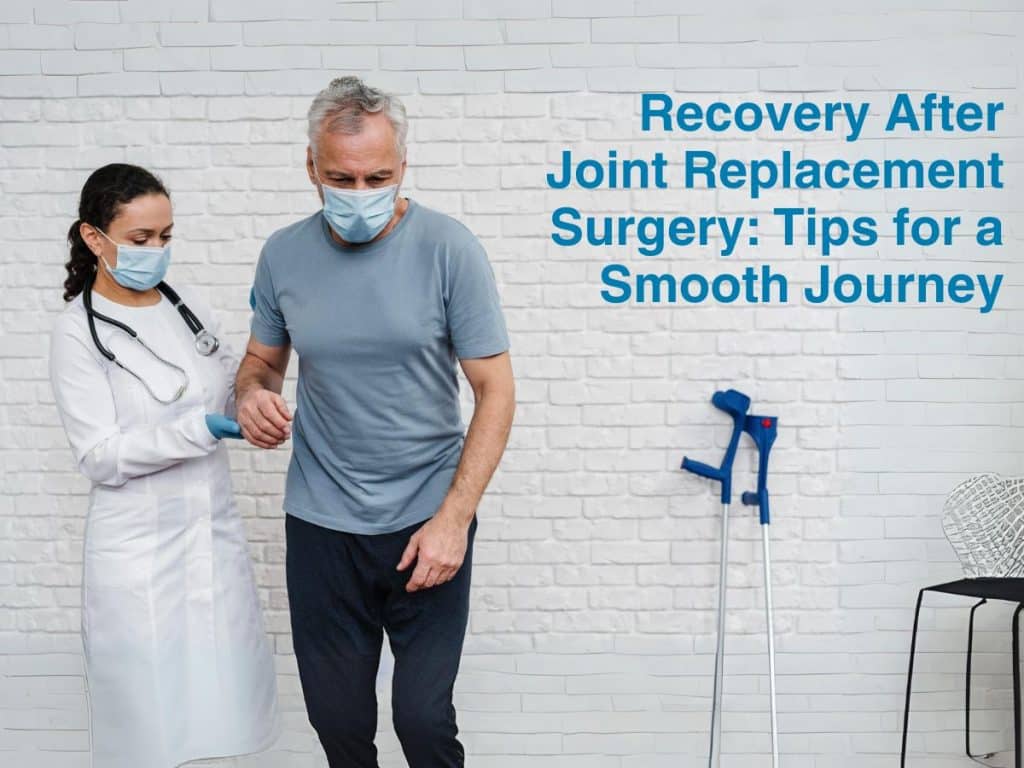
Recovery After Joint Replacement Surgery: Tips for a Smooth Journey

Joint replacement surgery can be a transformative experience, bringing relief from pain and restoring mobility. However, the journey to recovery is equally important and requires careful planning and commitment.
For individuals who have undergone this life-changing procedure, understanding how to navigate the recovery process can make all the difference.
1. Prepare for Recovery Before Surgery
Preparation for recovery should begin before the surgery itself. Creating a comfortable and safe environment at home is crucial. This includes clearing pathways of obstacles, setting up a designated recovery area with necessary items within reach, and arranging for assistance during the initial weeks post-surgery. It may also be beneficial to have a list of medications and supplies ready, as this can reduce stress during the recovery period
2. Follow Post-Operative Instructions
Post-operative care instructions provided by the healthcare team are tailored to each individual’s needs. Following these instructions diligently is vital for a smooth recovery. This often includes guidelines on managing pain, caring for the surgical site, and recognising signs of complications. Understanding when to contact the healthcare provider is equally important; prompt communication can prevent minor issues from becoming significant setbacks.
3. Engage in Physical Therapy
Physical therapy plays a pivotal role in recovery after joint replacement surgery. A personalised rehabilitation program designed by a physical therapist can help strengthen muscles, improve flexibility, and restore range of motion. Engaging in these exercises, even when they may feel challenging, is essential for regaining independence. Consistency in attending therapy sessions and performing home exercises is key to a successful recovery.
4. Prioritise Nutrition and Hydration
Nutrition greatly impacts healing after surgery. Consuming a balanced diet rich in vitamins, minerals, and protein can support the body’s recovery process. Foods high in calcium and vitamin D are particularly beneficial for bone health. Staying hydrated is equally important, as it aids in the healing process and helps to manage medication side effects.
5. Manage Pain and Discomfort
Pain management is an integral part of recovery. Understanding the prescribed pain management plan and using medications as directed can help alleviate discomfort. It is normal to experience some pain post-surgery, but patients should not hesitate to communicate any concerns regarding pain levels with their healthcare provider. Adjustments can often be made to ensure a more comfortable recovery experience.
6. Incorporate Rest and Relaxation
Rest is vital for recovery. Adequate sleep allows the body to heal and recuperate effectively. Creating a calming environment and establishing a regular sleep schedule can promote better rest. Incorporating relaxation techniques, such as deep breathing exercises or meditation, can also help manage stress and anxiety during the recovery process.
7. Stay Positive and Set Goals
Maintaining a positive mindset can significantly influence the recovery experience. Setting small, achievable goals can provide motivation and a sense of accomplishment as progress is made. Celebrating milestones, whether it’s walking unaided or regaining full range of motion, can boost morale and encourage persistence through the recovery journey.
8. Seek Support from Family and Friends
Recovery after joint replacement surgery can be challenging, but having a support system in place can ease the journey. Family and friends can provide emotional support, assist with daily tasks, and help ensure that the recovery plan is followed. Open communication about needs and feelings can strengthen these connections and foster a supportive environment.
To Conclude,
Recovery after joint replacement surgery is a journey that requires patience, effort, and support. By preparing adequately, following medical advice, and staying engaged in the recovery process, individuals can achieve a smooth and successful transition back to their daily lives.
Embracing a positive outlook and seeking help when needed can make this transformative journey a fulfilling experience, ultimately leading to a renewed sense of mobility and independence.
Frequently Asked Questions
How long does it take to recover from joint replacement surgery?
Recovery time varies depending on the type of joint replacement and the individual’s overall health. Generally, it takes about 6 to 12 weeks to resume most daily activities. However, complete recovery, including regaining full strength and mobility, can take up to a year. Regular follow-up with the healthcare team and adherence to rehabilitation exercises can help speed up the process.
When can normal activities be resumed after surgery?
While the timeline for resuming normal activities depends on the type of surgery and individual recovery, most patients can begin light activities within 4 to 6 weeks. Driving may be resumed once full mobility and reaction times are restored, typically after about 6 weeks. More strenuous activities, like sports, may take several months and should only be resumed after consulting with the healthcare provider.
What are the signs of complications after joint replacement surgery?
While complications are rare, it’s important to be aware of warning signs. These include excessive swelling, severe pain, redness or warmth around the surgical site, fever, or drainage from the incision. Any sudden difficulty in moving the joint or leg, chest pain, or shortness of breath requires immediate medical attention, as these could indicate serious issues such as infections or blood clots.
How soon can weight be put on the operated leg?
The ability to bear weight after surgery depends on the type of joint replaced and the specific surgical procedure. In many cases, weight-bearing activities can begin soon after surgery with the use of crutches, walkers, or other aids. The healthcare provider will provide guidance based on the individual’s progress and ensure that weight-bearing activities are introduced safely.
Will there be long-term restrictions after joint replacement surgery?
Most individuals are able to return to their usual activities after recovery, but some precautions may be necessary to protect the new joint. High-impact activities such as running, jumping, or contact sports may be discouraged to prevent wear and tear on the prosthesis. Low-impact activities like walking, swimming, and cycling are typically recommended for maintaining joint health and overall fitness.
How important is physical therapy after joint replacement surgery?
Physical therapy is crucial to a successful recovery. It helps strengthen the muscles around the joint, improves flexibility, and enhances mobility. The exercises prescribed by the physical therapist should be followed diligently, both in sessions and at home. Regular participation in therapy can significantly improve long-term outcomes and ensure a smoother, faster recovery.

Dr. Kushal Hippalgaonkar
MBBS, DNB (Orthopaedics)
Consultant Orthopaedic Surgeon






